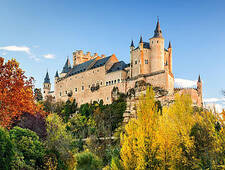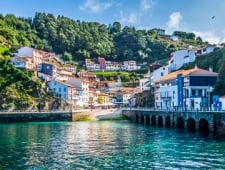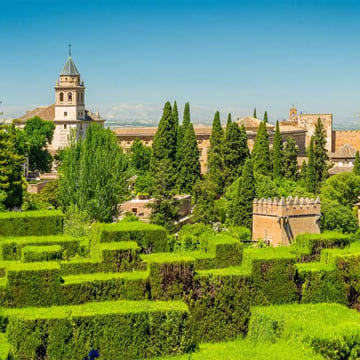 Visiting Granada is always an exciting idea. As part of the Andalusian region, Granada has a unique cultural scene, full of memorable activities, delicious food, and several historical landmarks.
Visiting Granada is always an exciting idea. As part of the Andalusian region, Granada has a unique cultural scene, full of memorable activities, delicious food, and several historical landmarks.
If you want to explore Granada like a local, this page is for you. It offers a complete Granada sightseeing guide for foreigners, covering not only Granada’s tourist attractions but also its vibrant cultural attractions.
First Look at Granada, Spain
Granada is an autonomous community in the Andalusian region. Its capital, also called Granada, is a stunning city positioned at the foot of the Sierra Nevada mountains. The area is surrounded by two beautiful lakes: Darro and Genil. Almost every street corner has a historical monument. The whole city is covered in olive, pomegranate, orange, and lemon trees. Nature, history, and beach lovers can all find something in Granada. It also has a precious location, only a 2.5-hour drive from Alicante. The roads are pleasant, filled with scenic views and pine trees.
Thanks to the low monthly expenses and peaceful daily life, Granada is a popular place for expats. Visit our related page if you are curious about other top places to live in Andalucia, Spain.
The Moorish Culture in Granada
In the 8th century, the Moors from North Africa conquered Andalucia and later established Granada as their capital. Their rule lasted until 1492, when King Ferdinand and Queen Isabella reclaimed the city. What remains today is a remarkable cultural and historical legacy visible in Granada’s Islamic architecture, cuisine, and traditions.
Granada's Moorish history influenced its food, architecture, and several daily practices. Therefore, you will see Moorish influence everywhere during your visit. Some of the cultural items include traditional teterías (Arab-style tea houses), intricate azulejos (tilework), carved stucco walls, horseshoe arches, and dishes like tajine, couscous, and pastela.
7 Must-Do Experiences in Granada
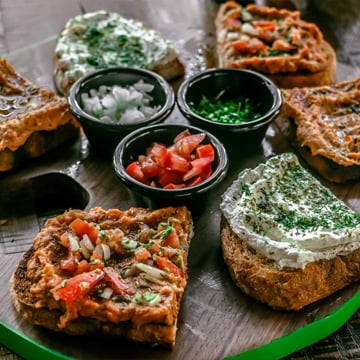 Below, we list the top 7 things to do in Granada Spain.
Below, we list the top 7 things to do in Granada Spain.
- Enjoy Local Cuisine & Tapas
The culinary culture is one of the best local experiences in Granada. The foods have a delicious blend of Andalusian flavours and local specialties. Most popular dishes in Granada are pionono (a syrupy sponge pastry), plato alpujarreño (a hearty mix of sausage, potatoes, and fried eggs), habbas con jamón (broad beans with ham), and olla de San Antón, a rustic stew.
You can find appetizers like olives and manchego cheese in all Spanish bars. Granada, however, takes this tradition a step further. Here, every drink you order comes with a free tapa, a mini-dish that reflects local flavors. These are often big portions featuring stews, toasts, seafood, or grilled vegetables, often served with freshly baked bread.
For memorable Granada food and drink experiences, we recommend you visit Restaurant Betula Nana, Papas Elvira, d’Sano, Tocateja, El Pescaito de Carmela, El Mercader, or Pimienta Rosa. Also, some of the best tapas bars in Granada include Los Manueles Reyes Católicos, Bar Poë, Casa Lopez, Bar La Riviera, and Taberna La Tana.
- Watch a Flamenco Performance
Granada is one of Andalusia’s most authentic flamenco capitals. Watching a live flamenco show is one of the best cultural things to do in Granada, especially in the iconic cave tablaos of the Sacromonte district.
Some of the most authentic Sacromonte caves flamenco include Peña la Platería, Cuevas Los Tarantos, Zambra María la Canastera, and Venta El Gallo, where both renewed and rising artists keep this centuries-old tradition alive.
- Experience a True Flâneur
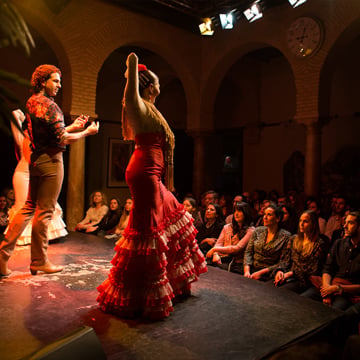 Granada’s narrow, authentic streets vividly picture centuries of history. Wandering these whitewashed alleys is one of the best ways to discover Granada’s hidden cultural gems that no guidebook could capture. For a true flâneur experience, you must:
Granada’s narrow, authentic streets vividly picture centuries of history. Wandering these whitewashed alleys is one of the best ways to discover Granada’s hidden cultural gems that no guidebook could capture. For a true flâneur experience, you must:
- Walk without a plan
- Don’t rush
- Stay curious and observe
- Visit the Local Gems
Local bazaars and random streets might reveal a long-standing tradition to observing eyes. Calle Calderería is one of such places. This lively street is lined with teterías (herbal tea shops), tapas bars, henna tattoo stands, and spice shops, all echoing the city’s Moorish roots. Similarly, the Alcaicería market in Granada is a great place for traditional shopping. Once served as the city’s main silk and spice bazaar during the Nasrid period, the market is now filled with shops selling handmade ceramics, lanterns, textiles, and spices.
Another exciting activity is exploring the Realejo quarter, officially known as Realejo-San Matias. The neighborhood offers a blend of Moorish, Jewish, and Christian influences and many hidden places to visit in Granada, Spain. The old courtyards, traditional Carmen houses, the Sephardic Museum, and the Cristo de los Favores statue all tell a unique story.
Calle Oficios is another must-see place. Only 130 meters long, the street is often described as an open-air museum, with landmarks like Palacio de la Madraza, the modern art hub Centro José Guerrero, and the historic Royal Chapel, and an iconic neogothic iron gate called the Reja, dating back to 1915.
Finally, if you love biking, head to the Darro River Street. A ride alongside the river and hill views can be a refreshing experience.
- Enjoy the Night Life
.jpg) If you are curious about Granada nightlife and local bars, you will be glad to find many options. The city is filled with university students. So, the vibe is youthful and budget-friendly.
If you are curious about Granada nightlife and local bars, you will be glad to find many options. The city is filled with university students. So, the vibe is youthful and budget-friendly.
You can start your evening in the tapas bars in Realejo quarters and then head to Albaicín neighborhood Granada for lively bars or late-night cafes. If you are looking for an upbeat place, try nightclubs like El Camborio, Boogaclub, and Planta Baja. They offer live shows, DJ sets, flamenco performances, and electronic beats
- Watch the Sunset at Mirador de San Nicolás
Mirador de San Nicolás is a stunning viewpoint located at the highest point of Albaicin. This scenic spot offers a picture-perfect panorama of the snow-capped Sierra Nevada Mountains and the majestic Alhambra Palace. Watching the Mirador de San Nicolás sunset view can become a core memory you’ll never forget.
- Enjoy a Beach Day
Granada’s coastal towns may be small and somewhat limited. That said, you can still experience a relaxing beach day, admiring the mountain views and swimming in a warm sea. Coastal towns such as Motril, Salobreña, and Almuñécar are just a short drive away. Granada enjoys a long beach season with its long, dry summers and plenty of sunny days.
If you’re looking for amenities like sunbeds, umbrellas, and a cafeteria, then La Joya, Calahonda, and Salobreña beaches are ideal choices. If you prefer a more tranquil atmosphere, La Rijana, Carchuna, and El Ruso beaches are perfect for you.
Top 7 Places to Visit in Granada, Spain
- The Alhambra
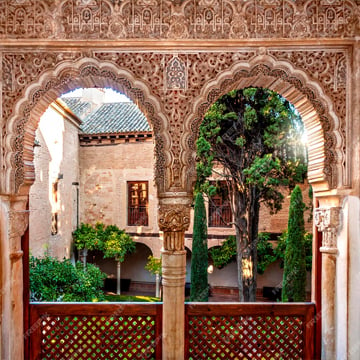 The Alhambra is a stunning complex of palaces, courtyards, and gardens. Originally built in the 9th century, the site became the most important political center of the Muslim West during the Nasrid Dynasty in the 13th century. After the Christian conquest in 1492, Renaissance elements were added. Today, the site is listed among UNESCO World Heritage Sites.
The Alhambra is a stunning complex of palaces, courtyards, and gardens. Originally built in the 9th century, the site became the most important political center of the Muslim West during the Nasrid Dynasty in the 13th century. After the Christian conquest in 1492, Renaissance elements were added. Today, the site is listed among UNESCO World Heritage Sites.
Alhambra is worth visiting, particularly for its;
- The Alhambra Palace (Red Castle): Visible from Granada’s city center, this impressive structure was expanded and redeveloped over centuries. Initially built as a modest castle, it evolved into a magnificent symbol of Moorish and later Christian power. Visiting the Alhambra Palace is an essential experience for anyone coming to Granada.
- Nasrid Palaces: Once served as the royal residence of the Nasrid dynasty, the palaces stand out with delicate stucco work, wooden ceilings, and geometric tile patterns, making it one of the finest examples of Islamic art in Europe.
- Generalife Gardens: Also known as the Royal Orchard, Generalife served as the residence for the sultans. Located near the Darro River, the site features lush green gardens and a water flow. At the entrance, you will find the Acequia Courtyard with its beautiful pool.
- Basilica of San Juan de Dios
This glamorous structure is a perfect example of Baroque church architecture. The interiors of the basilica are decorated richly, with a standout color of gold. Several polychrome wood sculptures of Saint San Juan’s tomb, who was the patron saint of the sick, are placed in the Basilica. His tomb is adorned with candles, flowers, and symbolic references to the saint, while his personal belongings are also on display.
The dome above is filled with angelic figures and paintings of the saint. Throughout the basilica, you’ll find a rich collection of paintings, sculptures, and religious artifacts.
We recommend you take your time to discover every single detail, including the San Juan de Dios Alms Basket, the main hall, and the impressive main altarpiece featuring a figure of the Virgin.
- Sierra Nevada
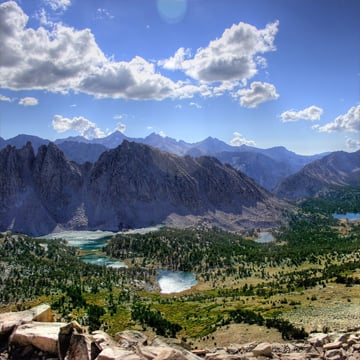 Sitting at 3,300 meters, Sierra Nevada Ski Resort is the highest skiable slope in whole Spain. Recognized as a UNESCO Biosphere Reserve, Granada Sierra Nevada tourism is highly popular. The site has 112.5 km of skiable terrain, restaurants, bars, nurseries, and sportswear stores.
Sitting at 3,300 meters, Sierra Nevada Ski Resort is the highest skiable slope in whole Spain. Recognized as a UNESCO Biosphere Reserve, Granada Sierra Nevada tourism is highly popular. The site has 112.5 km of skiable terrain, restaurants, bars, nurseries, and sportswear stores.
The resort is conveniently located just 31 km from Granada, 168 km from Malaga, 397 km from Alicante, and 422 km from Madrid. Daily buses depart from both Granada and Madrid bus stations, and many agencies offer day trips from Granada to Sierra Nevada.
If you visit during the summer months, there’s still plenty to enjoy. Many adventurers come with a dream of hiking in the Sierra Nevada, Granada. Hiking through the lush valleys and lakes is also a memorable experience.
- Granada Cathedral
Built between 1523 and 1569, Granada Cathedral is one of the most popular historic Sites in Granada, Spain. It stands as a masterpiece of Spanish Renaissance architecture, with lingering touches of Gothic and Baroque styles.
The majestic façade features three grand arches. The interior has long columns, altarpieces, and a dome. From the main chapel to the apse, every detail reflects the spiritual vision of its time. We suggest joining a guided Granada Cathedral tour to fully capture the essence of the place.
Located in the heart of the city, the cathedral is easily reached on foot. It is closed on December 24, 25, and January 1, and unavailable to tourists during liturgical ceremonies. Check the visiting hours in advance.
- Royal Chapel
The Islamic rule in the Iberian Peninsula came to an end with the Granada War (1482-1492). After the conquest, Isabella I of Castile and Ferdinand II of Aragon decided to construct a sepulchral chapel on the site of the main mosque in Granada. The building was completed in 1517.
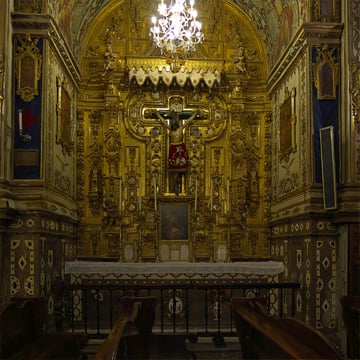 Today, the site includes the tombs of Isabella I, Ferdinand II, and their daughter, Joanna, and her husband Philip. The site also includes the Sacristy Museum, where the belongings of the Catholic Monarchs are displayed. Visitors can see paintings by Flemish artists, along with the queen’s ceremonial objects, books, and jewelry.
Today, the site includes the tombs of Isabella I, Ferdinand II, and their daughter, Joanna, and her husband Philip. The site also includes the Sacristy Museum, where the belongings of the Catholic Monarchs are displayed. Visitors can see paintings by Flemish artists, along with the queen’s ceremonial objects, books, and jewelry.
- Granada Science Park (Parque de las Ciencias)
This 70,000 m² interactive science museum is a must-visit for people of all ages. Located near Granada’s historic center, the museum features seven permanent exhibition halls in addition to several temporary exhibitions. This modern museum also includes a digital planetarium, a BioDome, a biblioLAB, and an auditorium.
Astronomy, physics, chemistry, mechanics, literature, and architecture lovers are guaranteed to find something exciting in the museum. You can participate in Botanical Tours and Mental Gymnastics, and visit attractions such as the Observation Tower, Tropical Butterfly House, Plan Labyrinth, and Escape Room.
The museum also offers engaging activities like "100 Years of Relativity," "Eureka," and "Foucault's Pendulum," allowing visitors to solve puzzles, test various physical phenomena, and be amazed by the wonders of science.
- The Bañuelo (Baño del Nogal)
Hammams hold significant importance in Islamic culture, serving not only as bathhouses but also as social hubs. The Bañuelo is a notable example of this tradition in Granada. Originally built in the 11th century, the structure continued to be actively used even after the fall of Granada to Spanish Catholics in 1492. In 1918, it was declared a Cultural Heritage site and eventually became a tourist attraction. The bathhouse features a relaxation room, a changing room, and three steam rooms: a cold room, a warm room, and a hot room.


